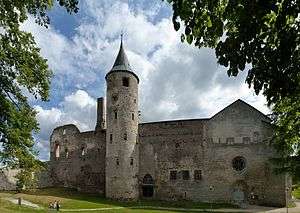Roman Catholic Diocese of Ösel–Wiek
| Bishopric of Ösel–Wiek | ||||||||||||||
| Bisdom Ösel–Wiek (nds) Ecclesia Osiliensis (la) | ||||||||||||||
| Prince-Bishopric of Terra Mariana | ||||||||||||||
| ||||||||||||||
 The Bishopric of Ösel–Wiek, shown (red, upper left, across the Estonian mainland and the islands of Dagö (Hiiumaa) and Ösel (Saaremaa)) within the Livonian Confederation, 1260 | ||||||||||||||
| Capital | Leal (Lihula) Perona (Vana-Pärnu) Hapsal (Haapsalu) Arensburg (Kuressaare) | |||||||||||||
| Languages | Low German, Estonian | |||||||||||||
| Religion | Roman Catholicism | |||||||||||||
| Government | Principality | |||||||||||||
| Prince-Bishop | ||||||||||||||
| • | 1228–1229 | Gottfried | ||||||||||||
| • | 1542–1560 | Johannes V von Münchhausen | ||||||||||||
| Historical era | Middle Ages | |||||||||||||
| • | Established | October 1, 1228 | ||||||||||||
| • | Sold to Denmark | 1560 | ||||||||||||
| ||||||||||||||
The Bishopric of Ösel–Wiek (Estonian: Saare-Lääne piiskopkond; German: Bistum Ösel–Wiek; Low German: Bisdom Ösel–Wiek; contemporary Latin: Ecclesia Osiliensis) was a Roman Catholic diocese and semi-independent prince-bishopric (parto of Terra Mariana, i.e. Livonia) in the Holy Roman Empire, covering what are now Saare, Hiiu and Lääne counties of Estonia.
History
- TO ELABORATE
The bishopric was created on 1 October 1228 as a Latin rite (initially exempt?) diocese by papal legate William of Modena and simultaneously as a state of Holy Roman Empire -making it a [[prince-bishopric- by Henry, King of the Romans (1220-1242; not Emperor). Due to the repeated shift of the seat of the bishops, it was also successively known as bishopric of Leal (Lihula) from 1234, Perona (Vana-Pärnu) from 1251, Hapsal (Haapsalu) Castle from 1279, and the seat shifted (alone) to the castle of Arensburg (Kuressaare) on the island of Ösel (Saaremaa); the cathedral and cathedral chapter (canons) remained in Hapsal. It was a suffragan diocese in the ecclesiastical province of the Metropolitan Archbishopric of Riga from 1253.
One of the five members of the Livonian Confederation, the state was administratively divided into two bailiwicks (Latin advocaciae, German Vogteien). The bishop was also the lord of the Teutonic Order over its fiefs on the bishopric's territory. From 1241 until 1343, Ösel (Saaremaa) Island was an autonomous part of Ösel-Wiek prince-bishopric (autonomy renewed 27 August 1255).
The principality ceased to exist in 1560 when its last prince-bishop, Johannes V von Münchhausen, sold it to Denmark, which vested executive power in royally appointed Governors (styled Lensmaend to 1654, then Statthalter). King Frederick II of Denmark's brother Magnus of Livonia, Duke of Holstein, obtained it as an appanage on 15 April 1560 and was elected bishop on 13 May 1560; the Danish dynasty being Lutheran, he abolished the diocese and assumed the secular feudal style Lord of Ösel (Stieffte Ozel und Wieck Herr) on 20 March 1567.
Denmark ceded Wiek (Lääne County) to the Polish-Lithuanian Commonwealth in exchange for parts of Ösel belonging to the Livonian Order. Later Ösel became a Danish possession.
Episcopal Ordinaries and Prince-Bishops of Ösel-Wiek (Saare-Lääne)
- Gottfried, Cistercian Order (O. Cist.) (1227, elected 29 June 1228; approved August 1228 – death 1229.07.26)
- vacancy & interregnum 1229 - 1234, ruled by the Bishop of Riga and the Livonian Swordbrothers Order.
- Heinrich I, Dominican Order (O.P.) (1235 – death 1260.03.10)
- Hermann I de Becheshovede (Buxhoevden) (1262– death 1285?)
- Heinrich II (1290.05.10 – death 1294)
- Jakob I (1294? – death 1307.01)
- Vacancy & Interregnum
- ? Konrad I 1297?–1307?
- Vacancy & Interregnum
- Hartung (Garttungus) (1312?10 – death 1320?21)
- Jakob II (1332.03.03 – 1337)
- Hermann II Osenbrügge (de Osenbrygge), (1338 – death 1362?63)
- Konrad II (1363.07.24 – death 1369?74)
- Heinrich III (1374.10.23 – death 1383), previously Bishop of Schleswig (Germany) (1370.01.30 – 1374.10.23)
- Vacancy & Interregnum
- Winrich von Kniprode (1385.03.28 – death 1419.11.05)
- Caspar Schuwenflug (1420.01.08 – death 1423.08.10)
- Christian Kuband, Norbertines (O. Praem.) (1423.08.10 – death 1432.07.21)
- Johannes I Schutte (1432.10.22 – ?1438)
- Johannes II Creul (Kreuwel), Teutonic Order (O.T.) (1439.03.20 de jure – 1457 de facto since 1449 in Wiek as the younger Bishop - death 1454.09.23))
- Ludolf Grove (1454?de jure – death 1458?) (de facto since 1439 as the older Bishop, since 1449 in Saaremaa and Dagö)
- Jodokus Hoenstein (1458.07.24 – death 1469?1471)
- Peter Wetberg (1471.06.17 – death 1491.11.21)
- Johannes III Orgas (Johann Orgies) (1492.03.26 – death 1515.03.19)
- Johannes IV Kyvel (Kievel) (1515.03.19 – death 1527?), succeeded as former Coadjutor Bishop of Ösel-Wiek (? – 1515.03.19)
- Georg von Tiesenhausen (1527.05.20 – death 1530.10.12), previously Bishop of Reval (Estonia) (1525.07.21 – 1530.10.12)
- Reinhold von Buxhoeveden (1532.07.08 – retired 1541), died 1557
- Johannes V von Münchhausen (1542.01.09 – 1560 deposed)
- Magnus of Livonia (also Prince of Denmark and Duke of Holstein), 1560–1572 (Protestant bishop, died 1583)
See also
Sources and external links
- Bibliography
- Pius Bonifacius Gams, Series episcoporum Ecclesiae Catholicae, Leipzig 1931, p. 297
- Konrad Eubel, Hierarchia Catholica Medii Aevi, vol. 1, p. 379; vol. 2, p. 207; vol. 3, p. 264
- Ernst Friedrich Mooyer, Verzeichnisse der deutschen Bischöfe seit dem Jahr 800 nach Chr. Geb., Minden 1854, p. 75
